
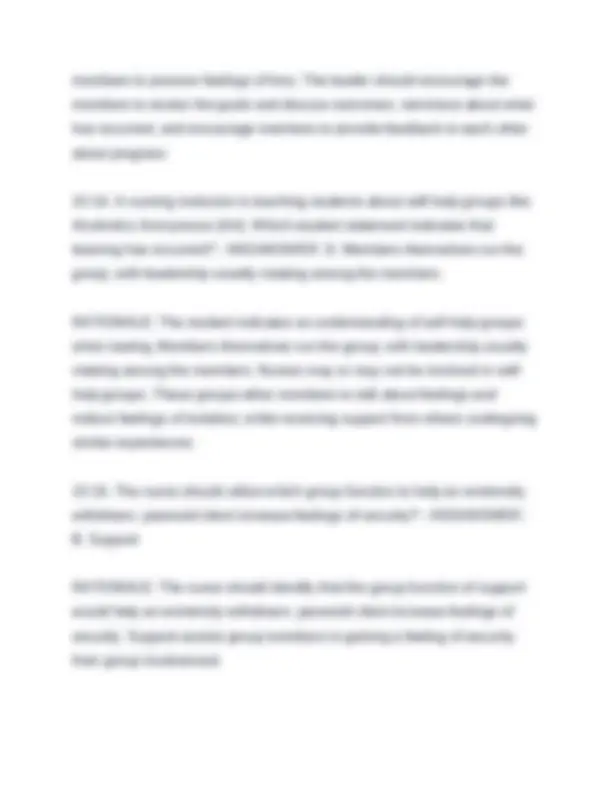
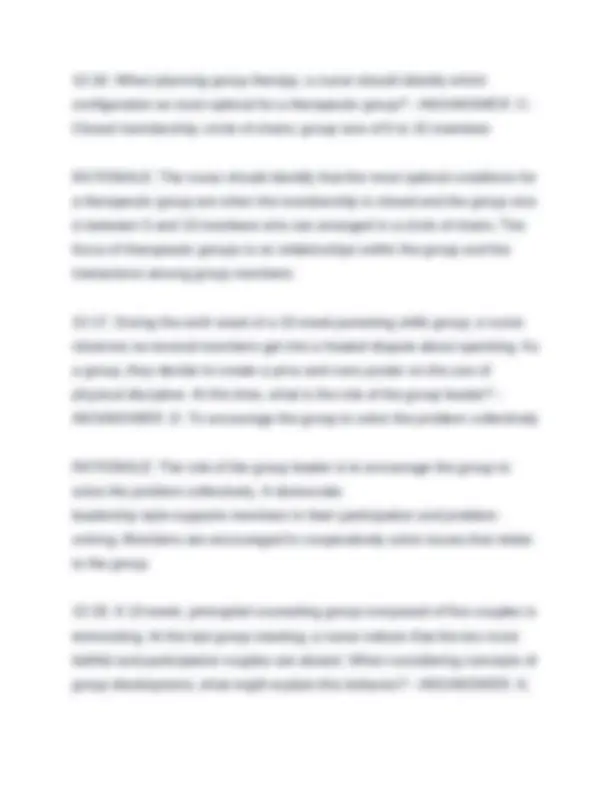
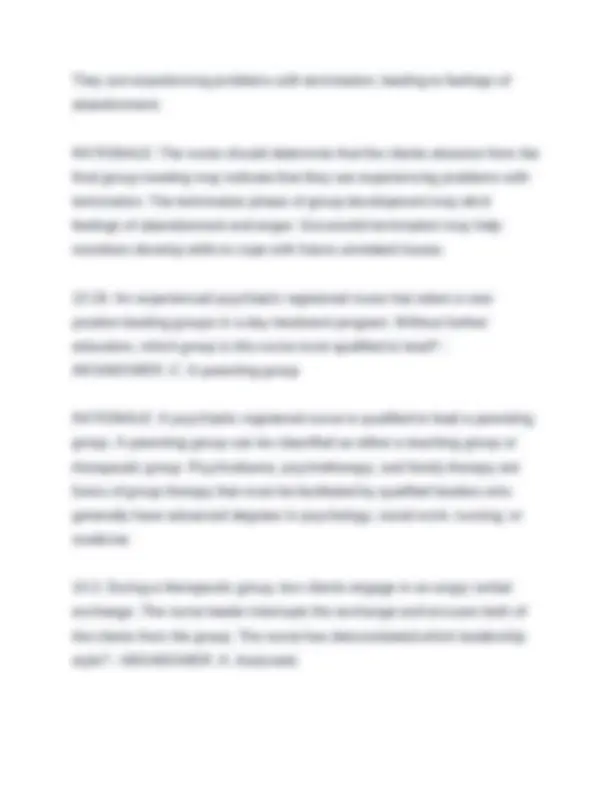
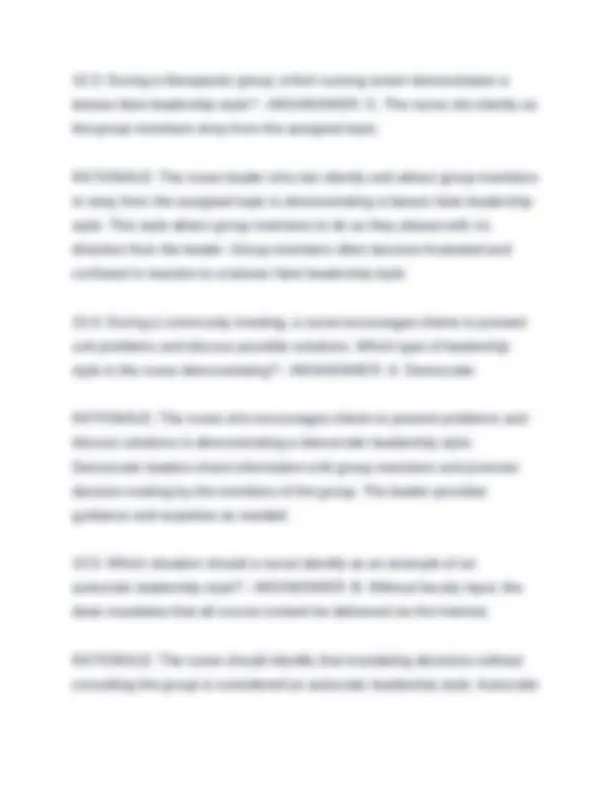
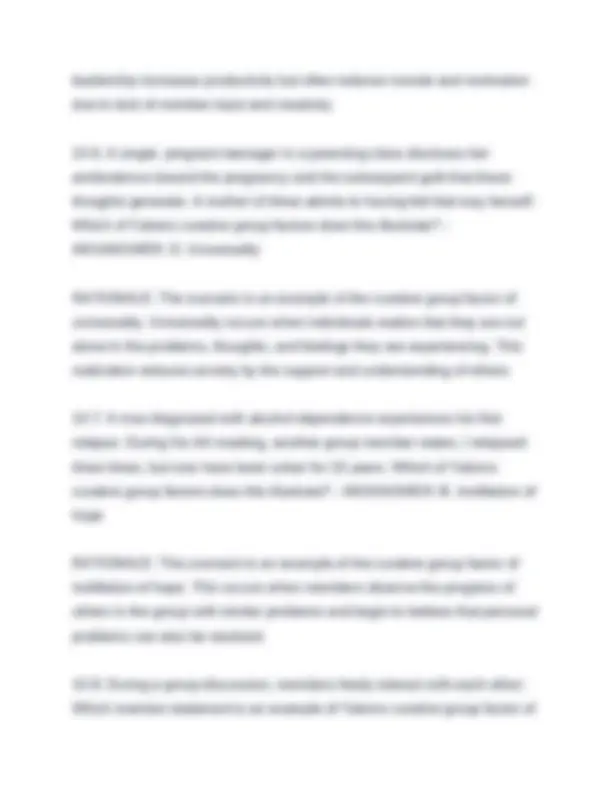
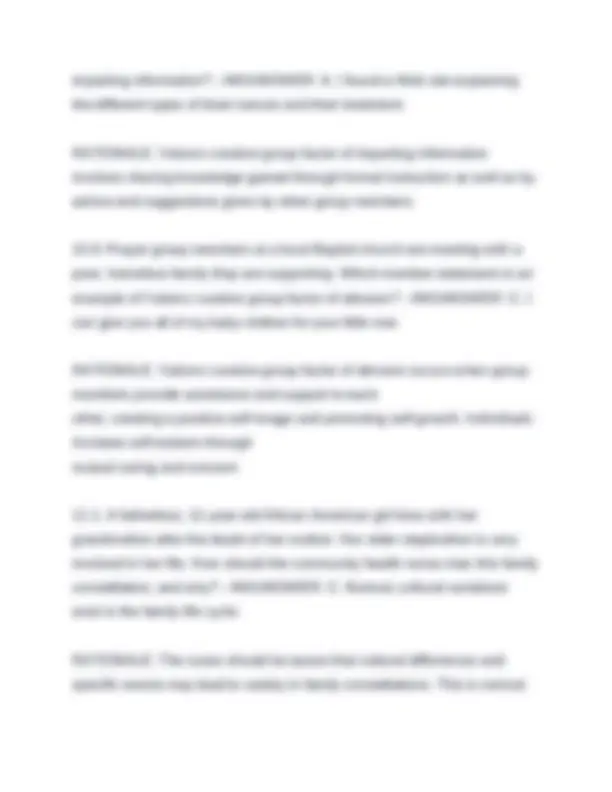
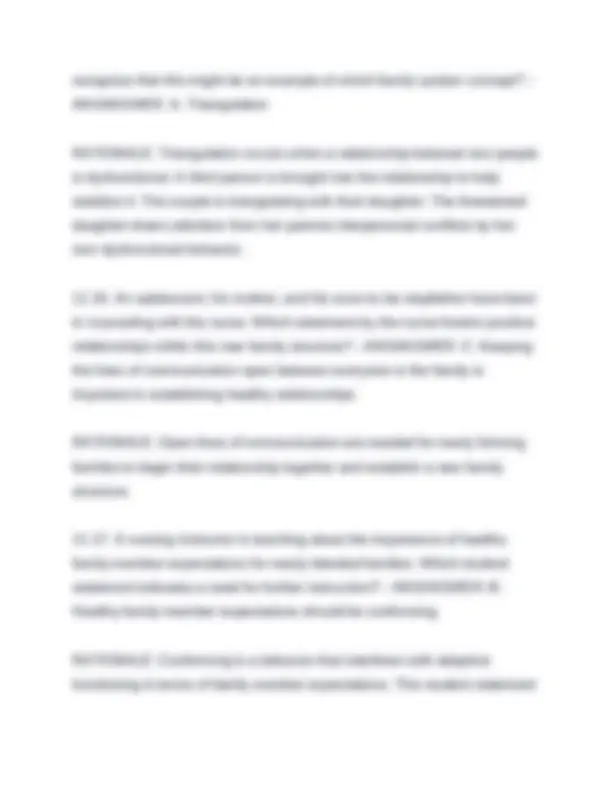
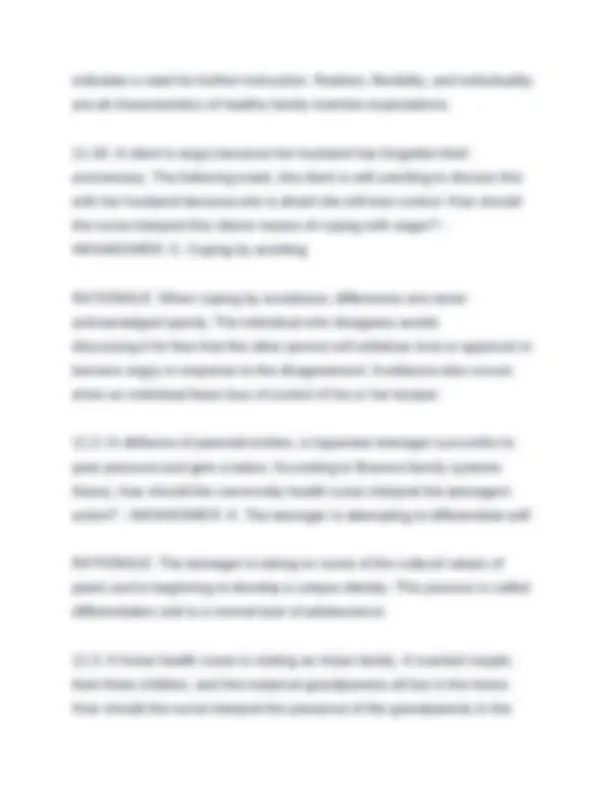
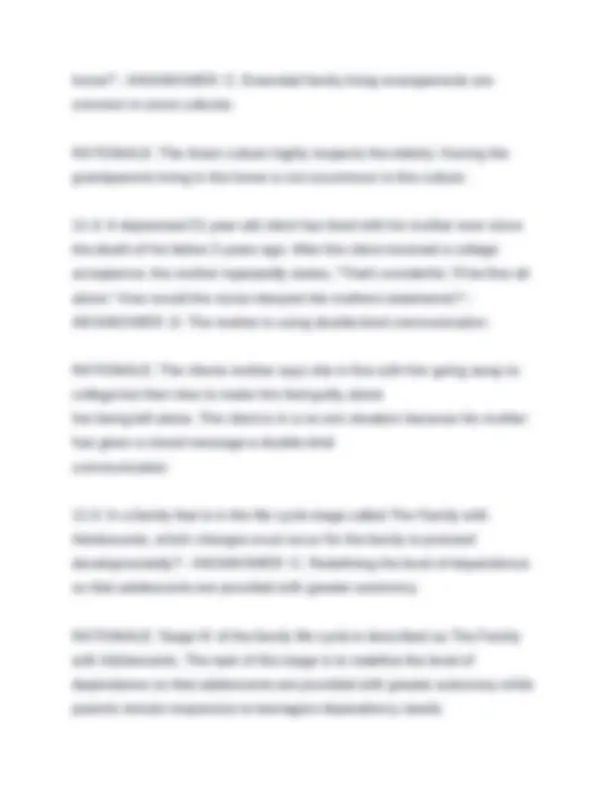
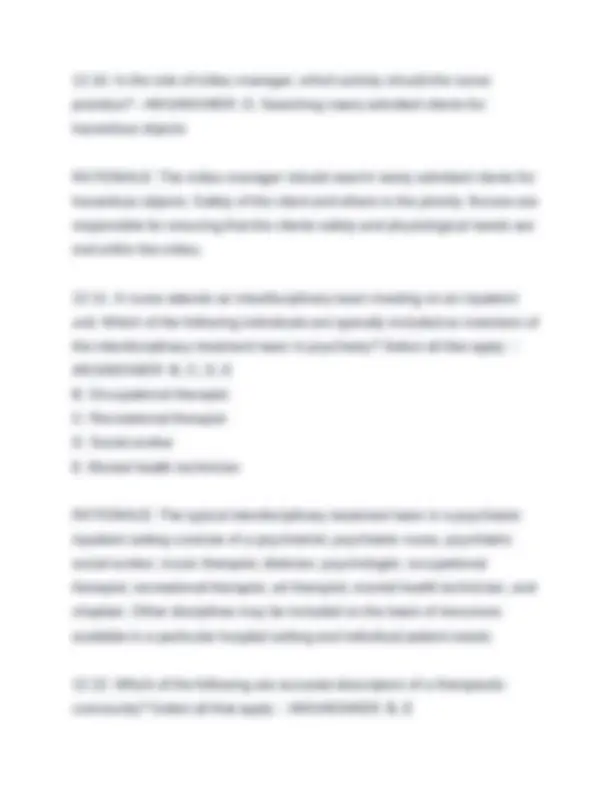
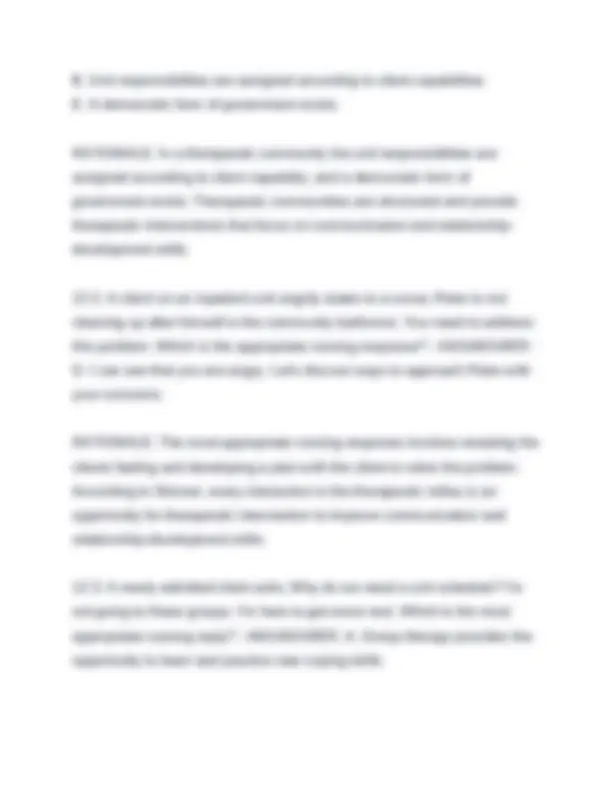
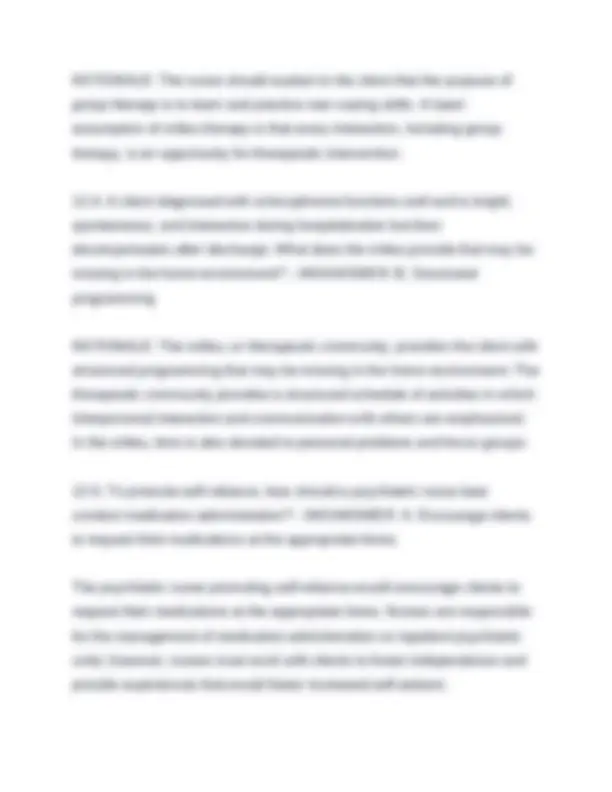
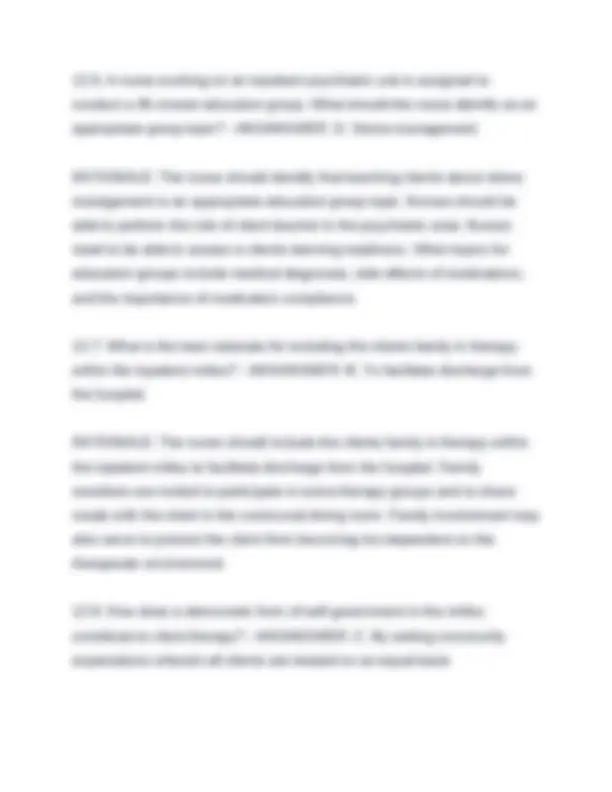
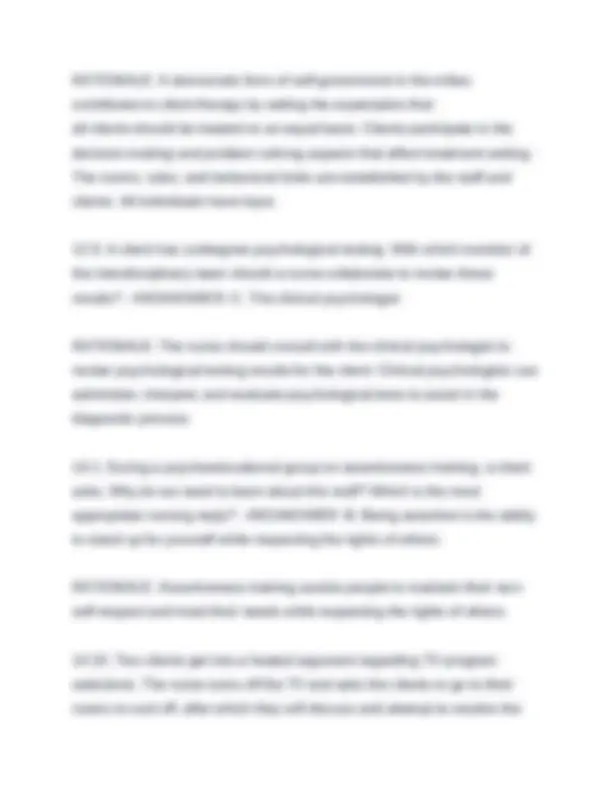
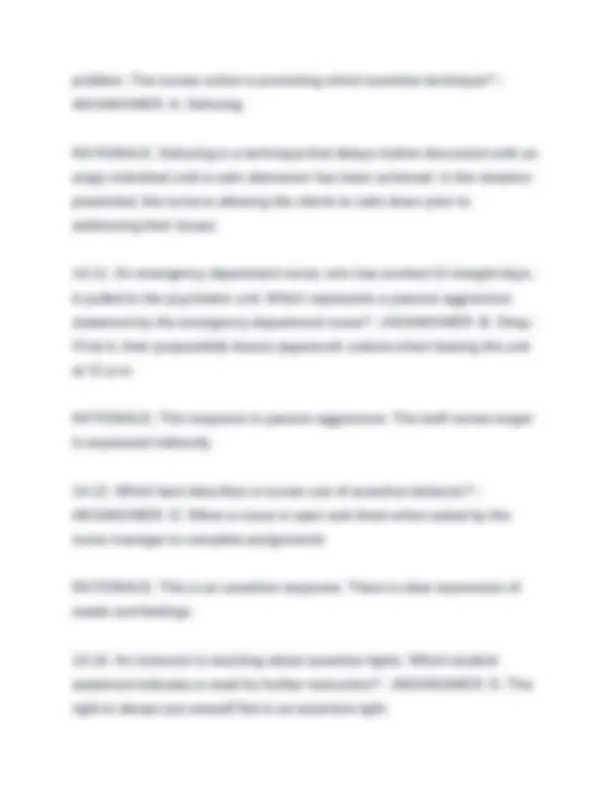
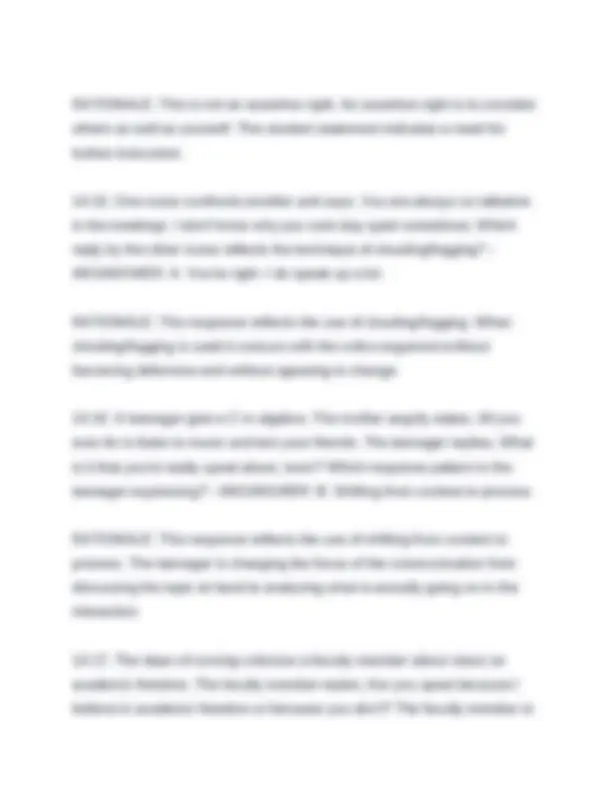
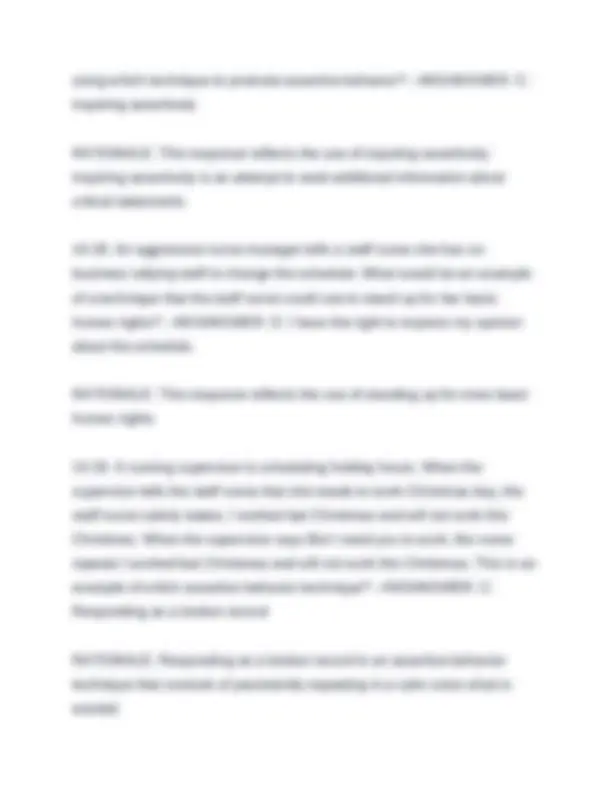
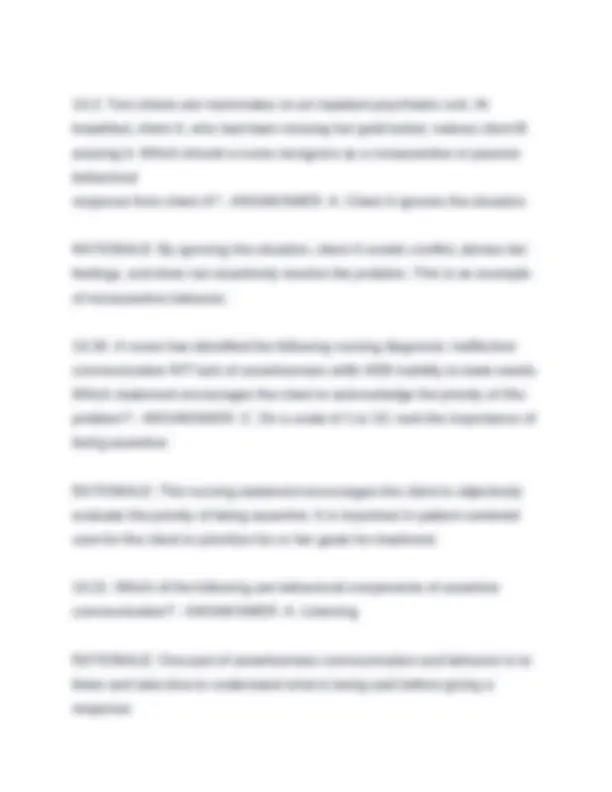
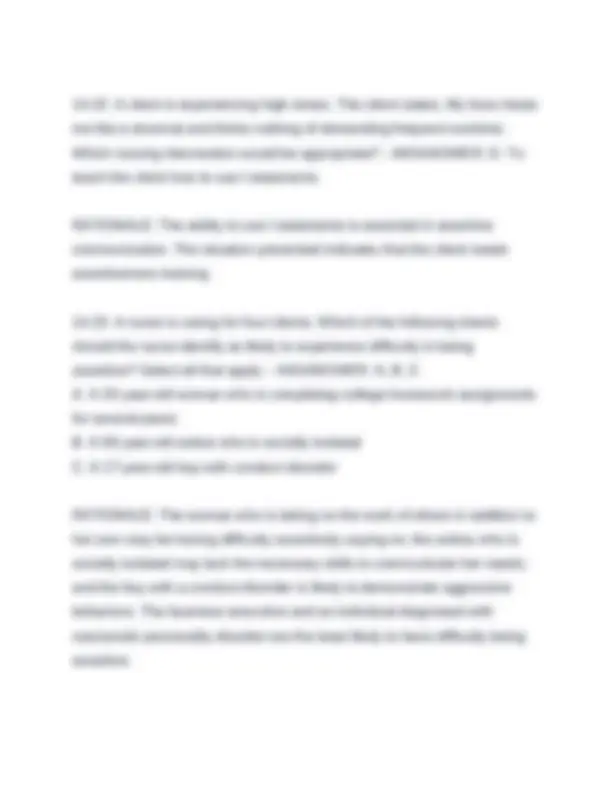
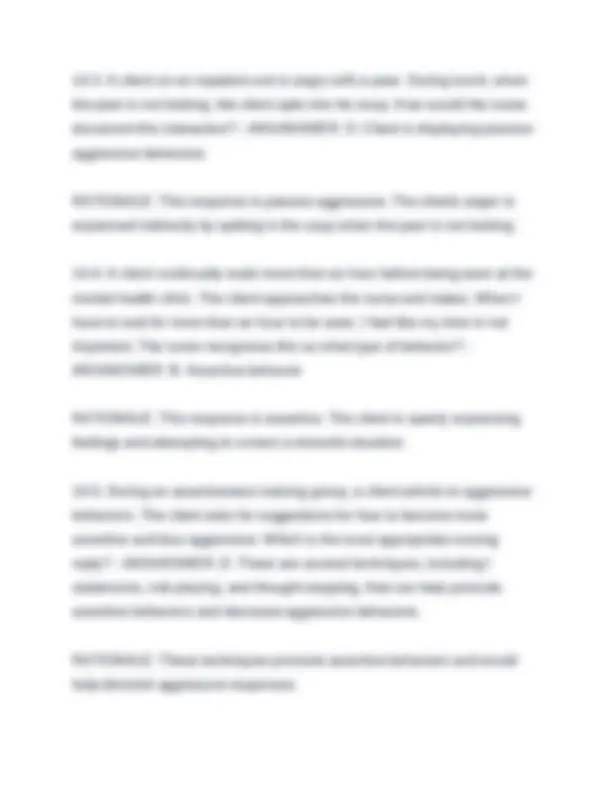
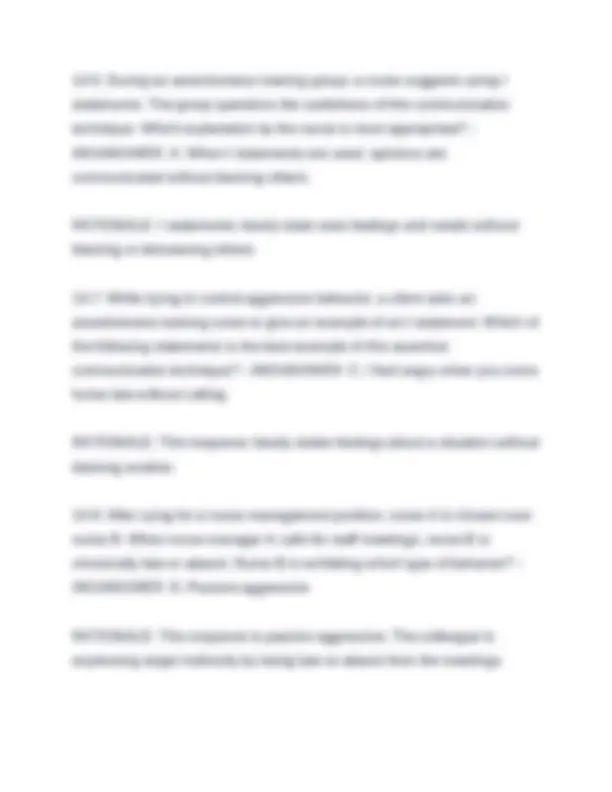
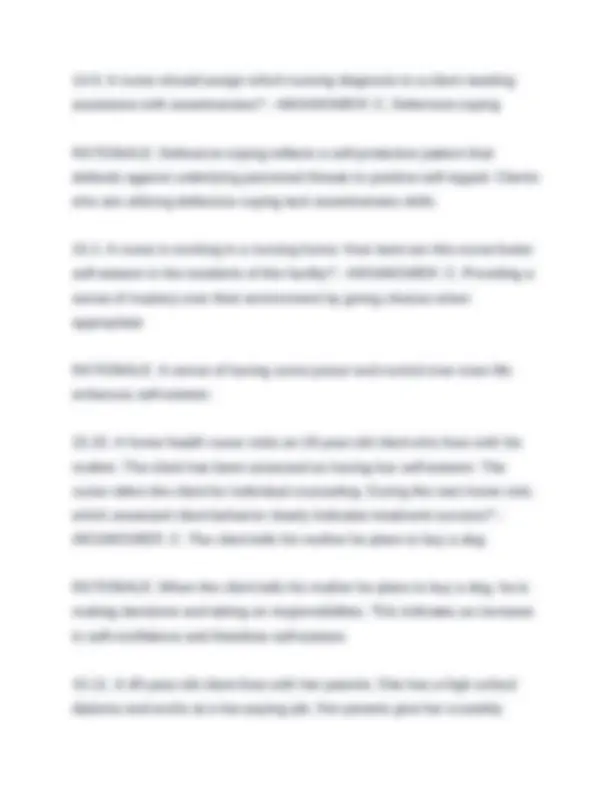
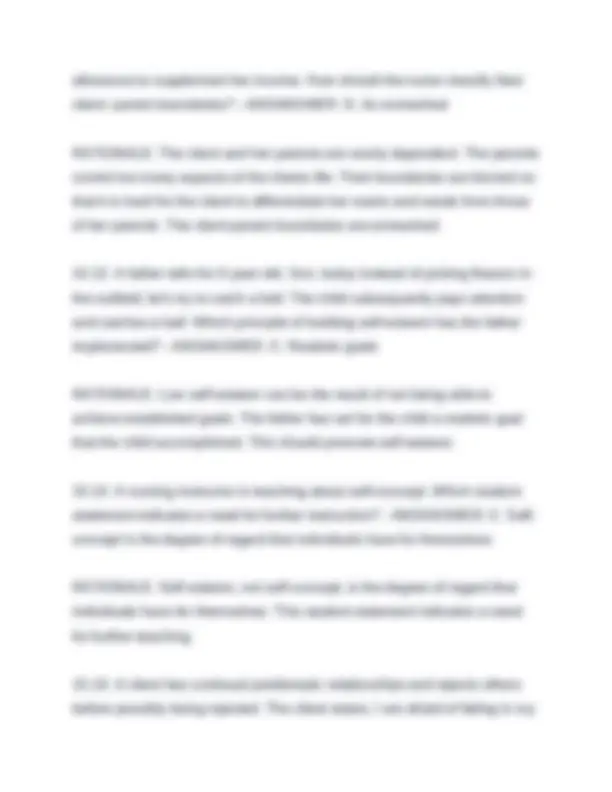
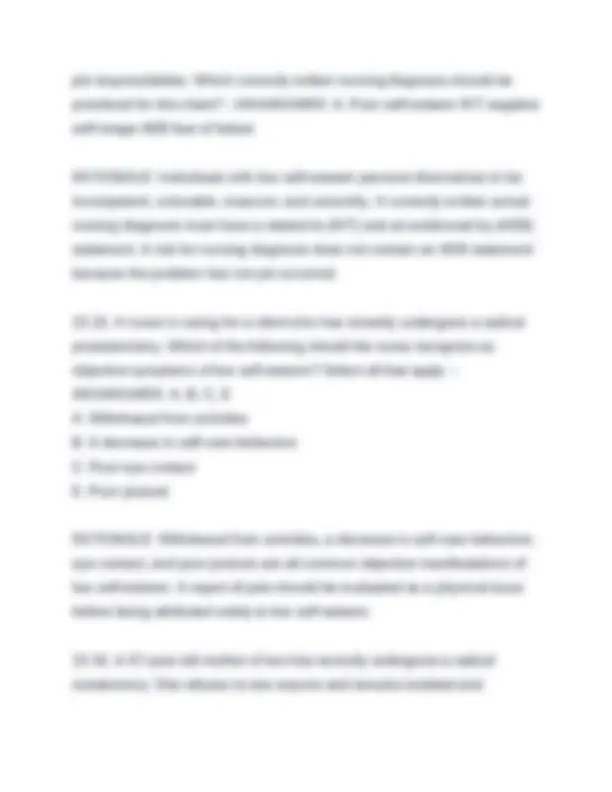
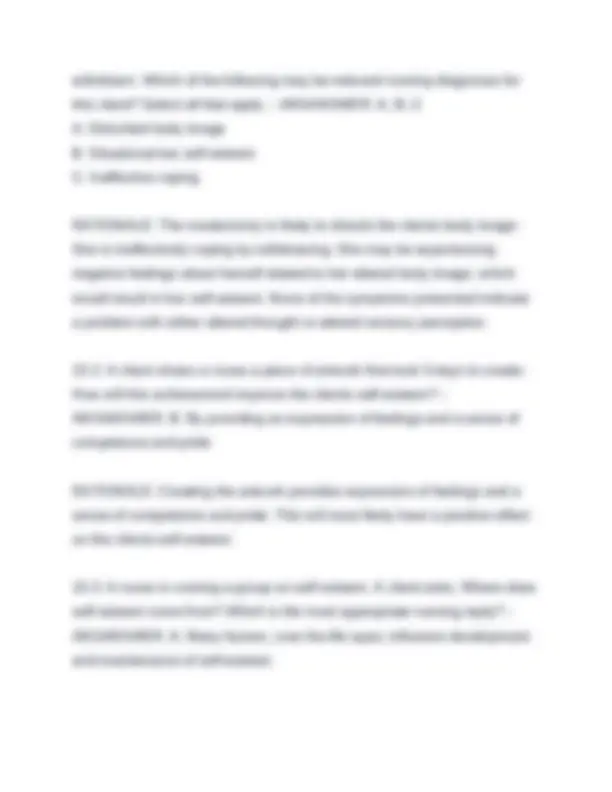
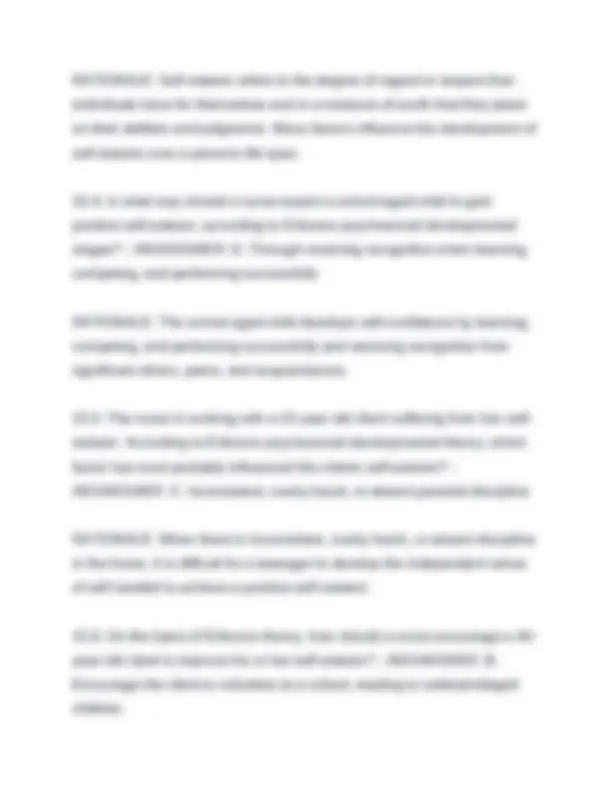
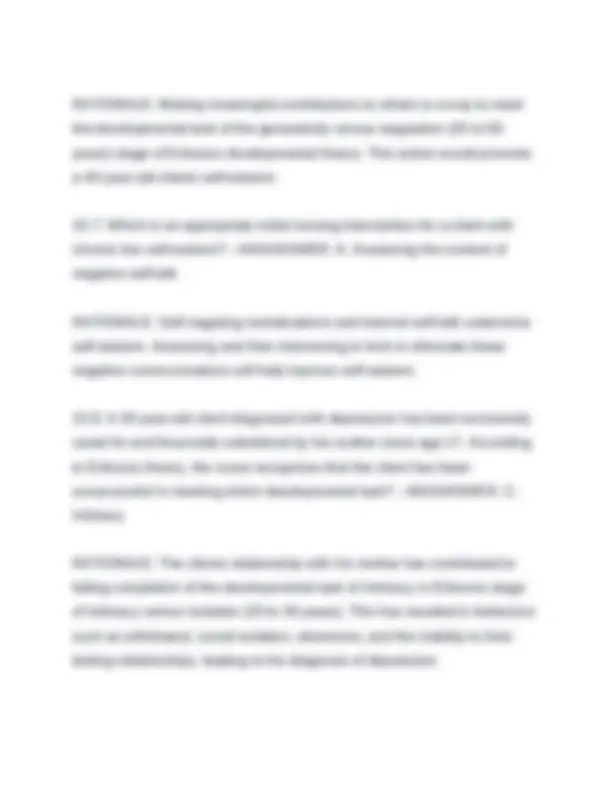
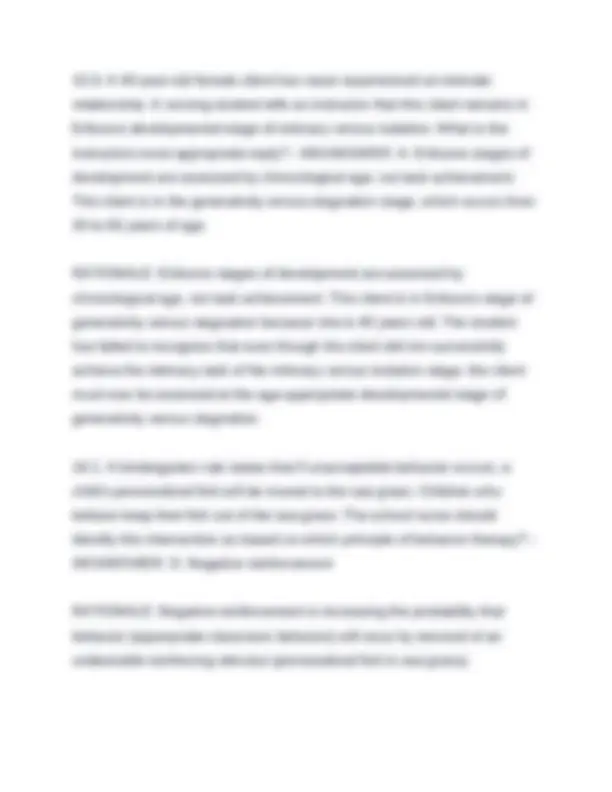
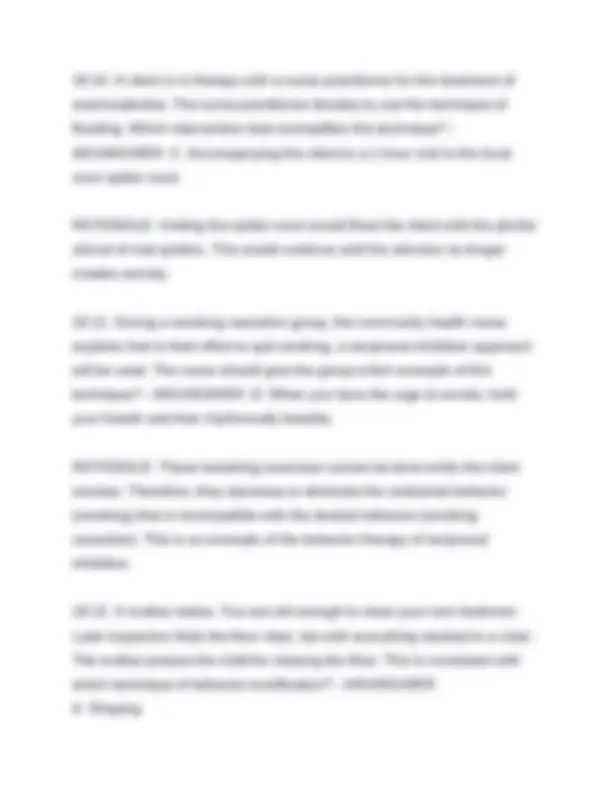
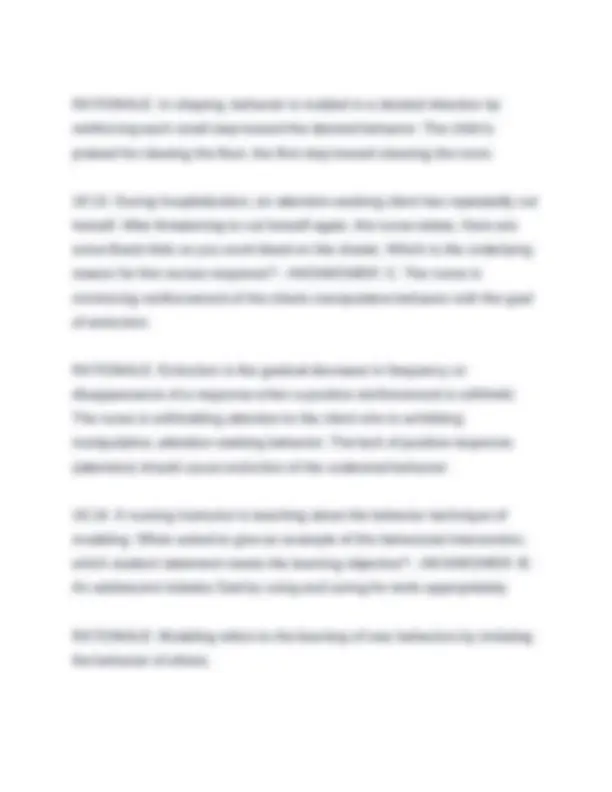
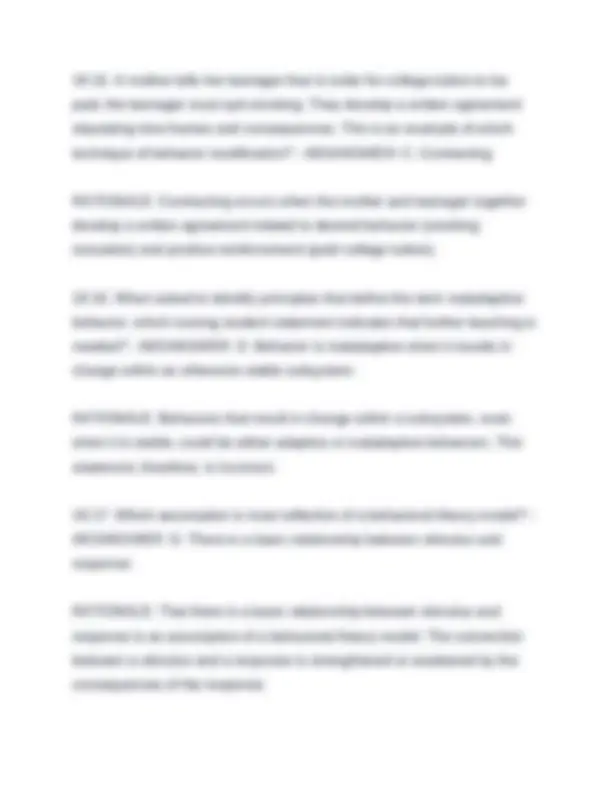
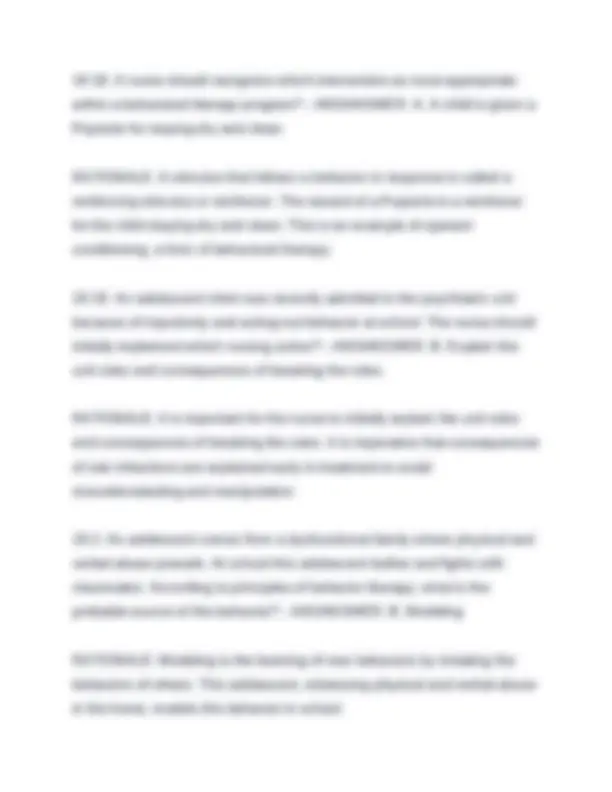
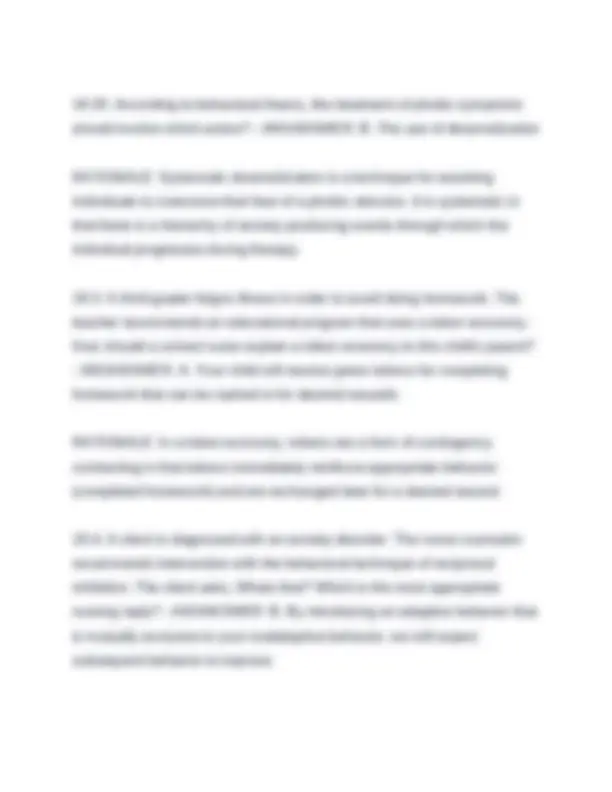
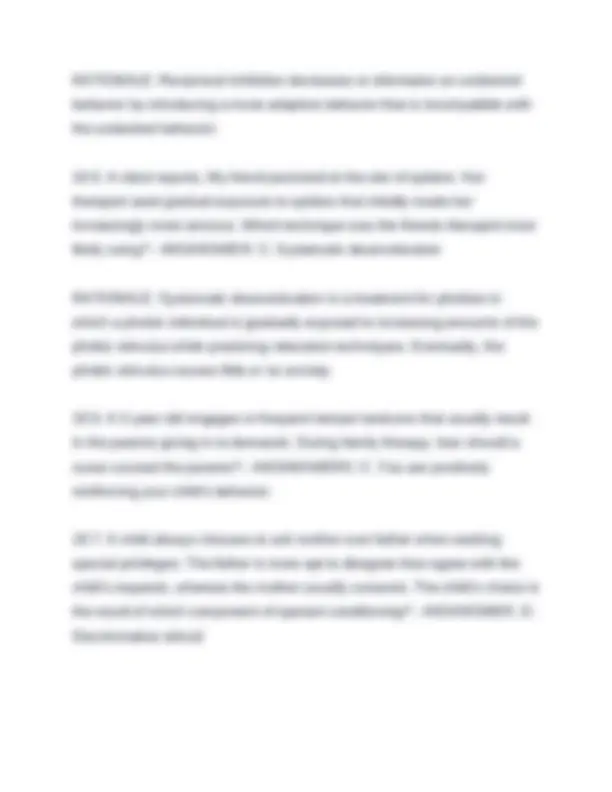
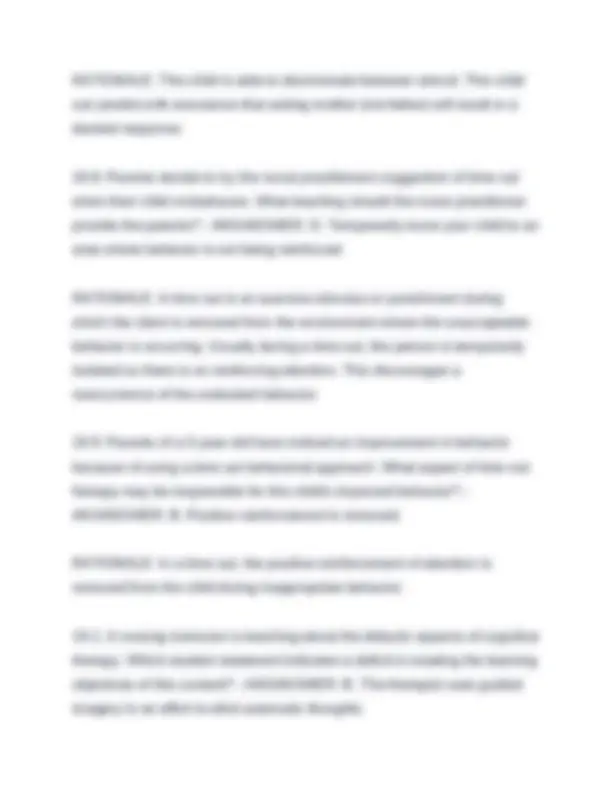
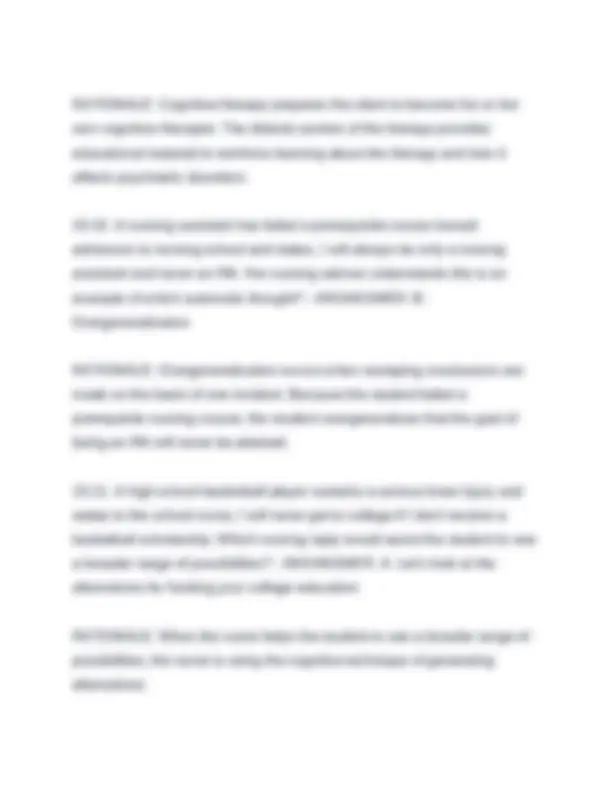
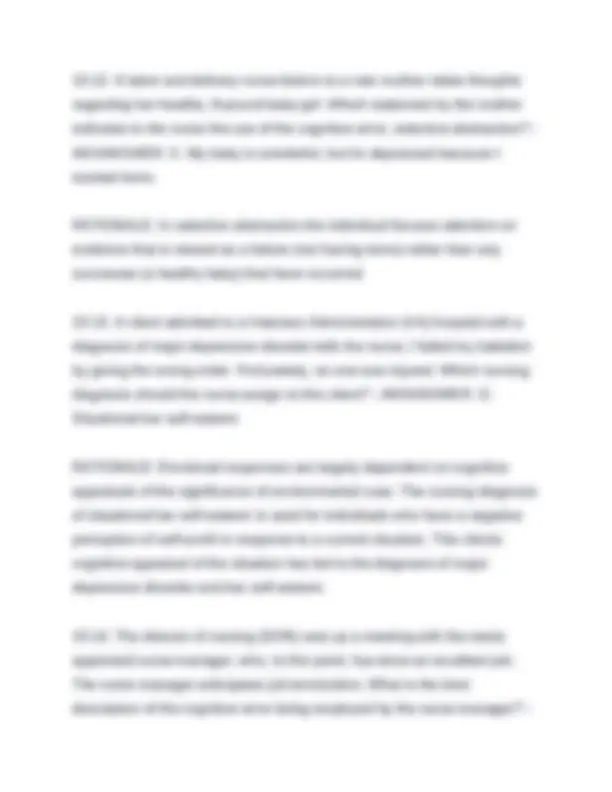
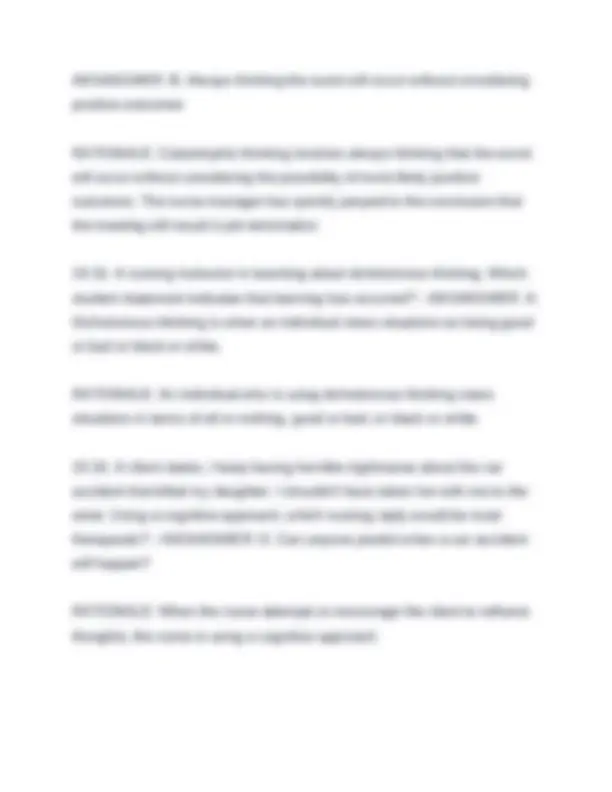
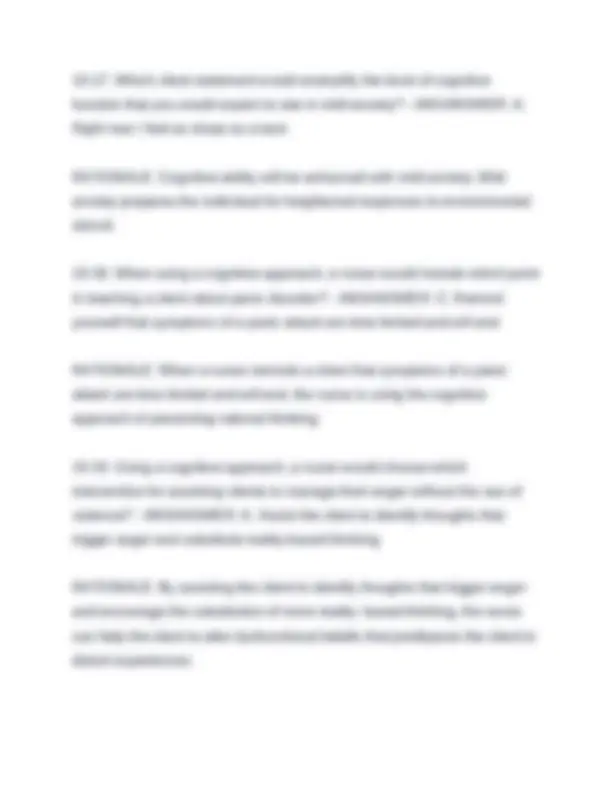
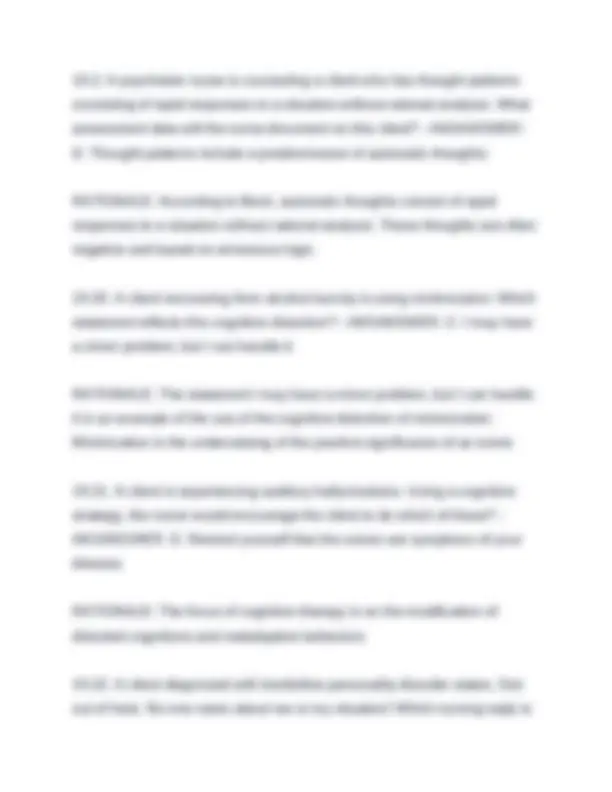
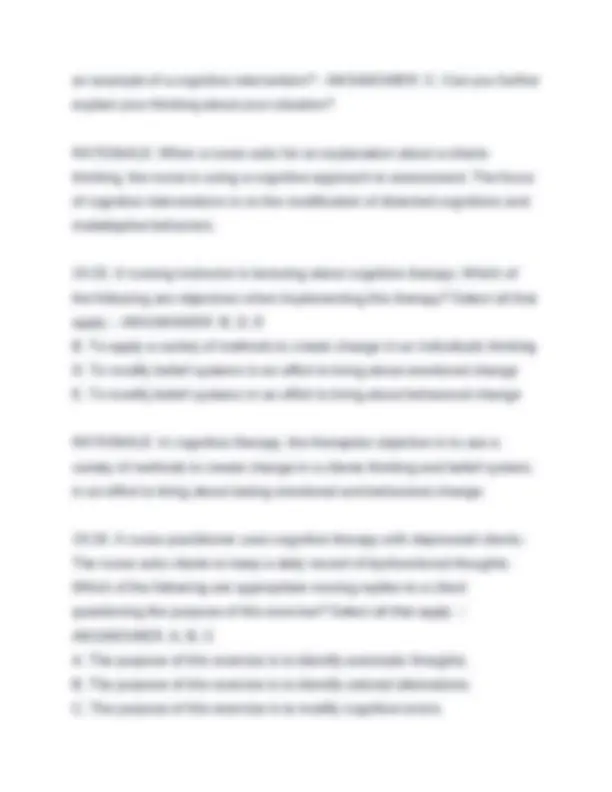
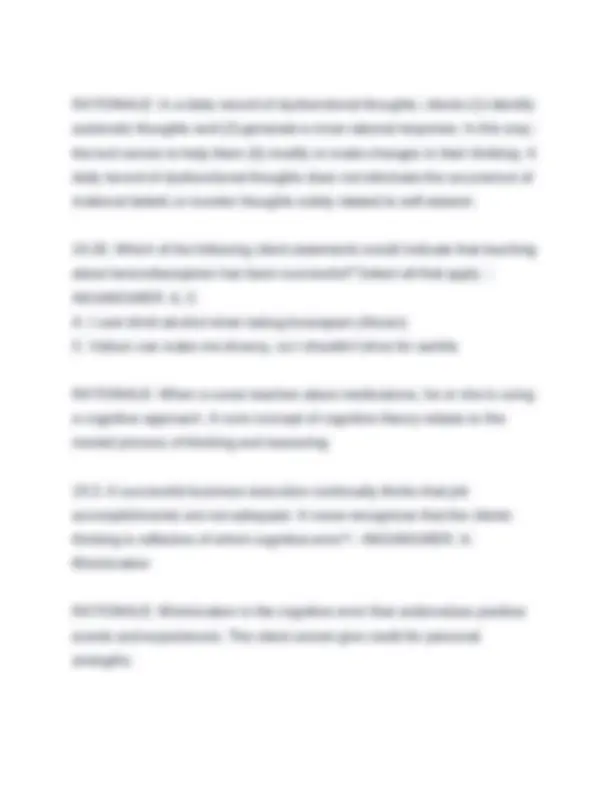
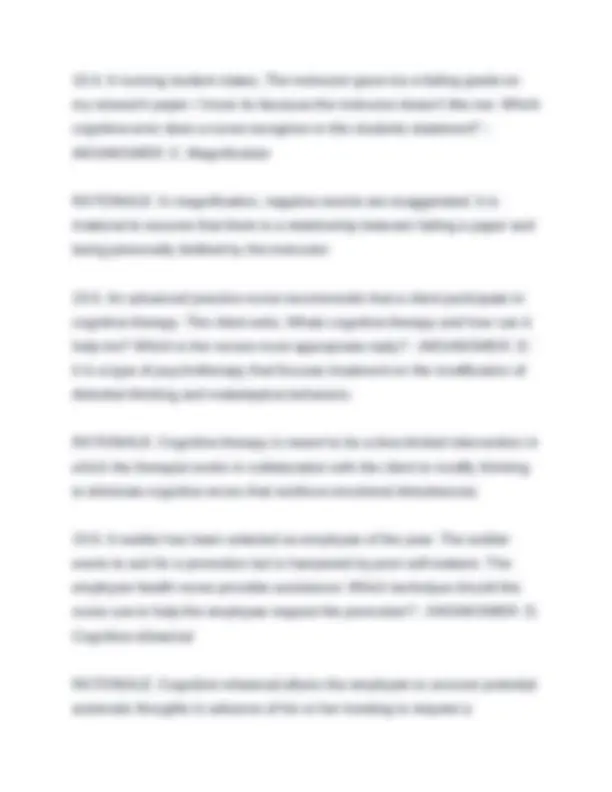
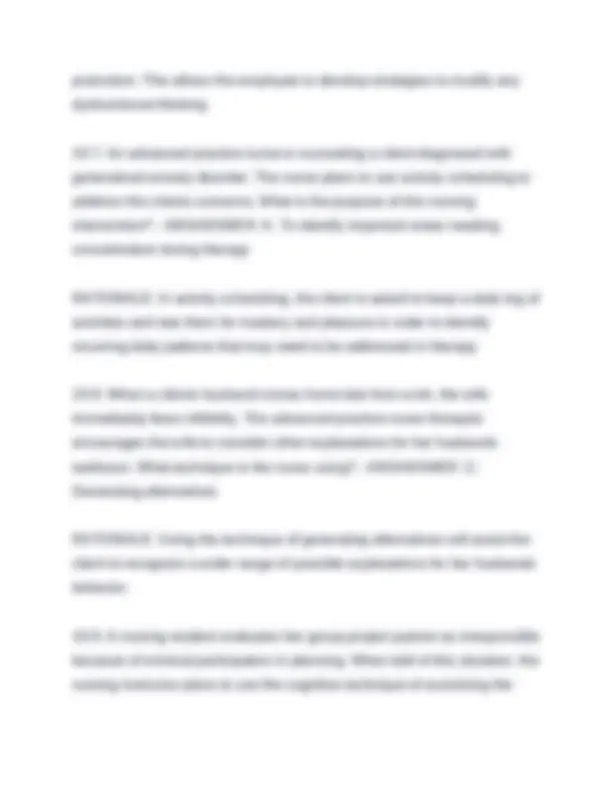
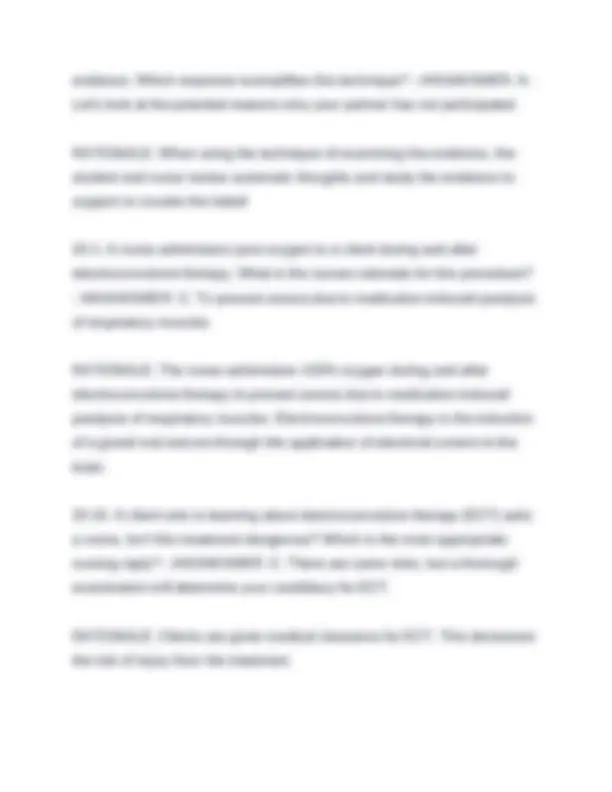
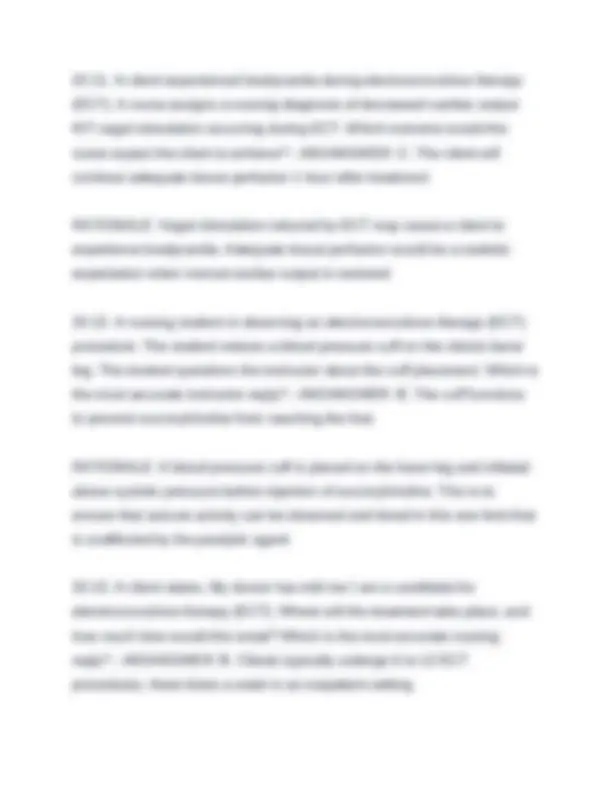
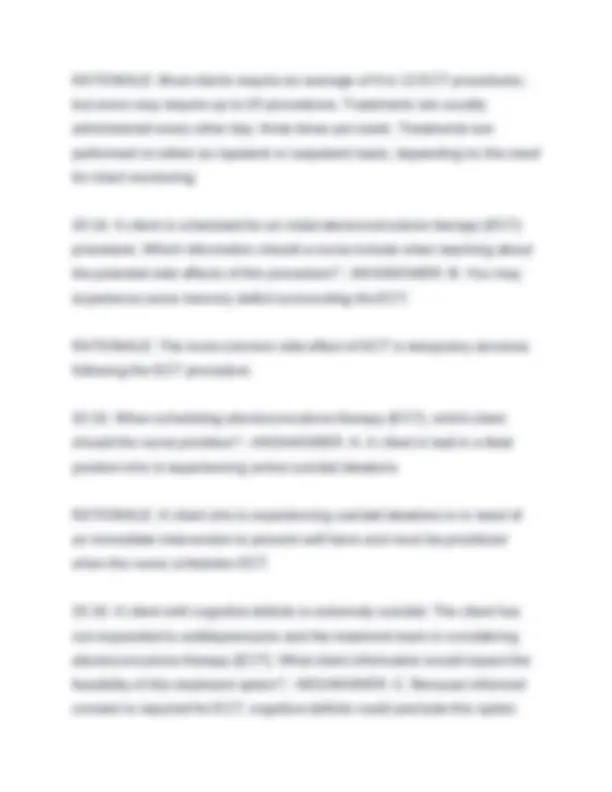
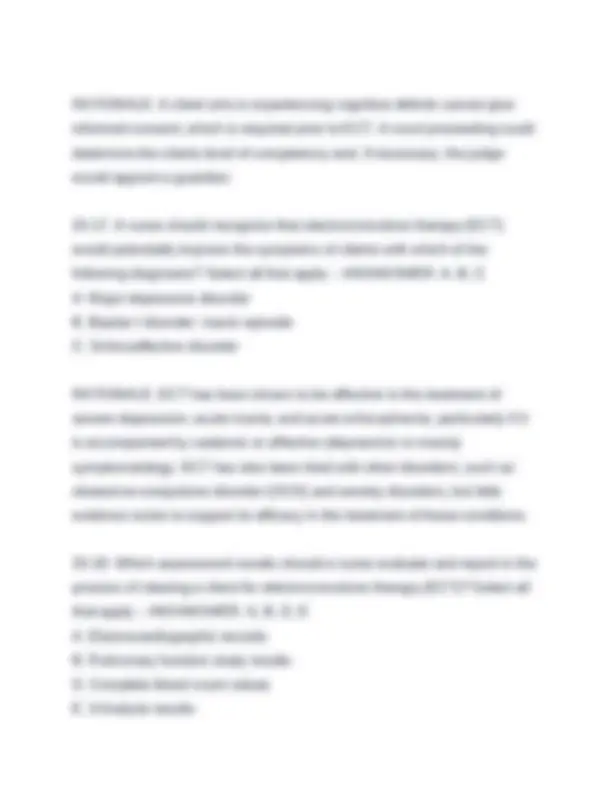
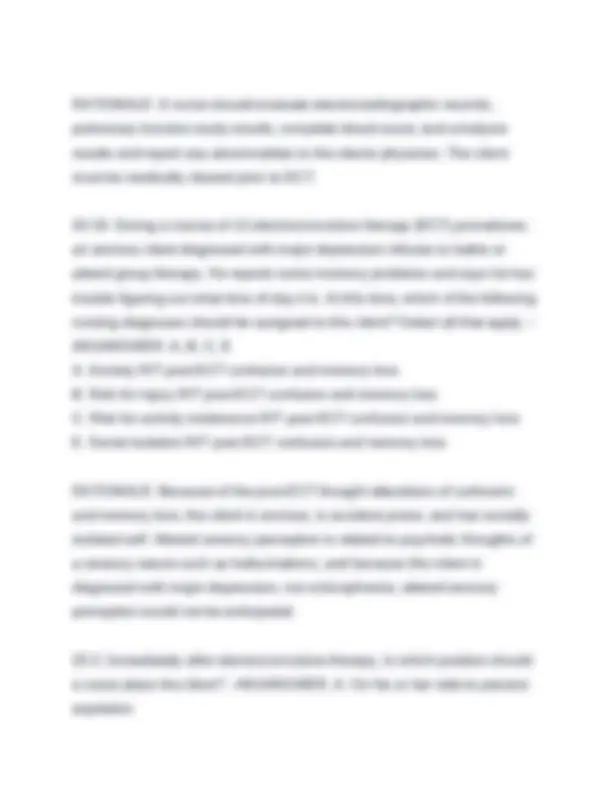
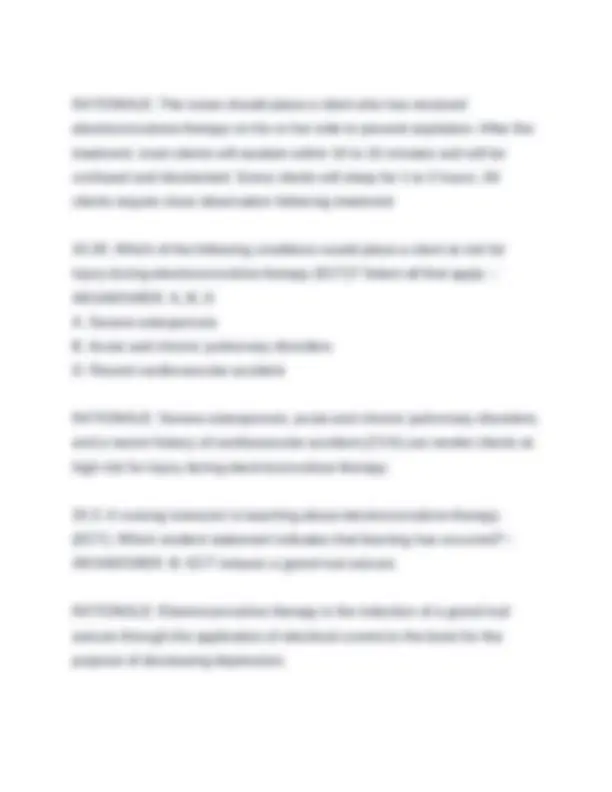
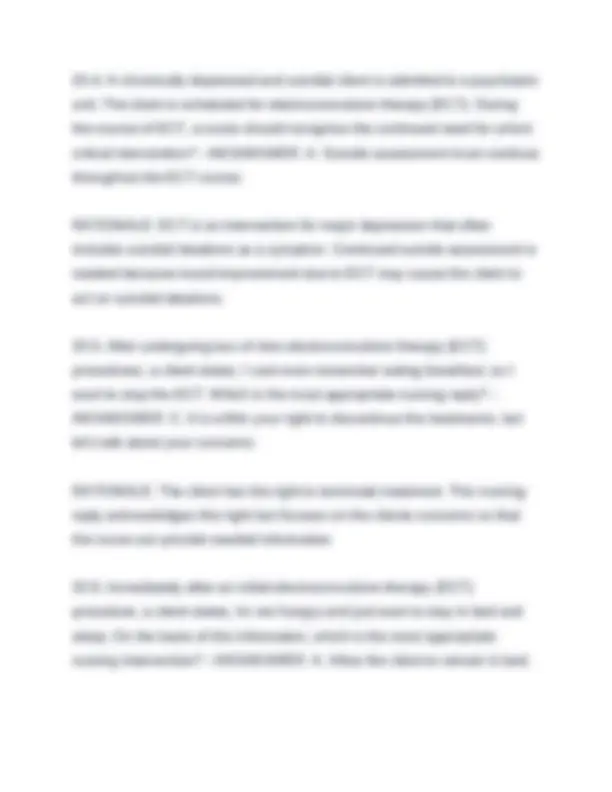
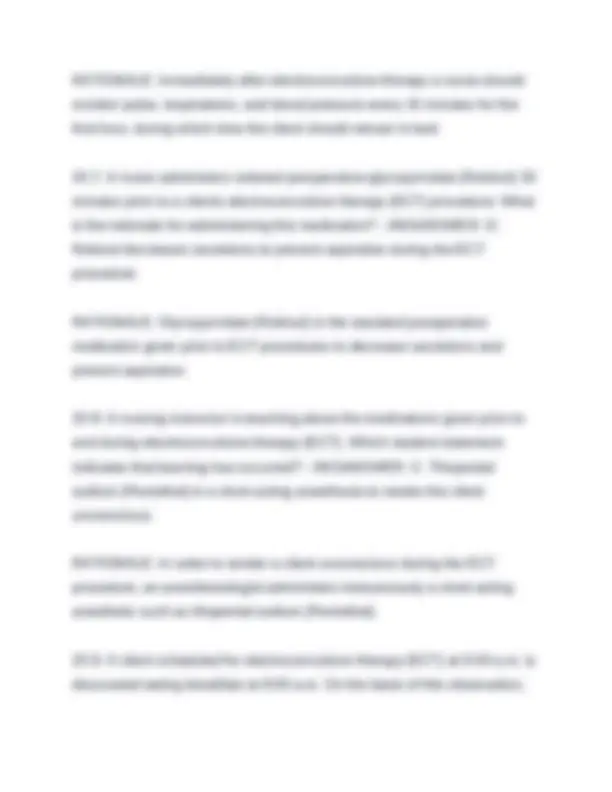
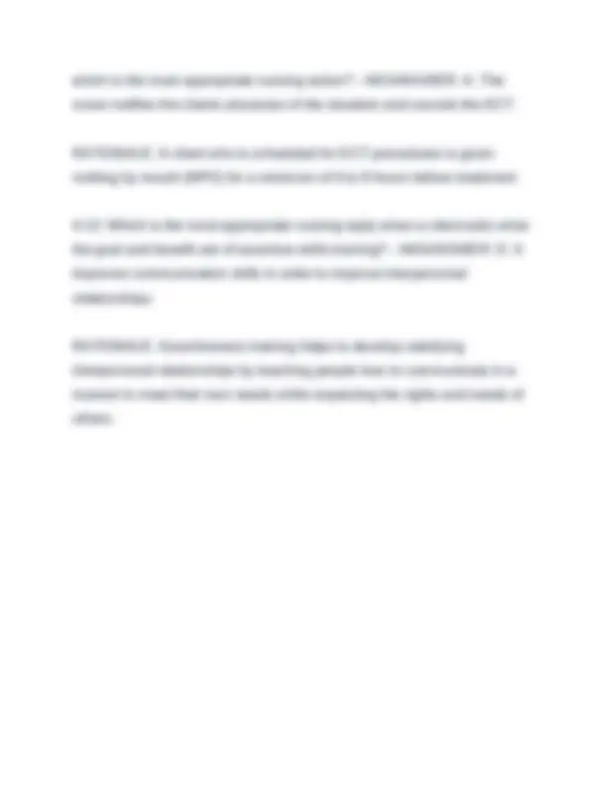


Study with the several resources on Docsity

Earn points by helping other students or get them with a premium plan


Prepare for your exams
Study with the several resources on Docsity

Earn points to download
Earn points by helping other students or get them with a premium plan
Community
Ask the community for help and clear up your study doubts
Discover the best universities in your country according to Docsity users
Free resources
Download our free guides on studying techniques, anxiety management strategies, and thesis advice from Docsity tutors
Unit III Mental Health Test Bank Updated Edition 2025-2026. Questions with Correct Answers. Graded A
Typology: Exams
1 / 61

This page cannot be seen from the preview
Don't miss anything!






















































10.1. During a therapeutic group, a client talks about personal accomplishments in an effort to gain attention. Which group role, assumed by this client, should the nurse identify? – ANS ANSWER: B. The individual role of recognition seeker RATIONALE: The nurse should evaluate that the client is assuming the individual role of the recognition seeker. Other individual roles include the aggressor, the blocker, the dominator, the help seeker, the monopolizer, and the seducer. 10.10. During an inpatient educational group, a client shouts out, This information is worthless. Nothing you have said can help me. These statements indicate to the nurse leader that the client is assuming which group role? - ANSANSWER: A. The group role of aggressor RATIONALE: The nurse should identify that the client is assuming the group role of the aggressor. The aggressor expresses negativism and hostility toward others in the group or to the group leader and may use sarcasm in an effort to degrade the status of others. 10.11. A nurse believes that the members of a parenting group are in the initial, or orientation, phase of group development. Which group behaviors
would support this assumption? - ANSANSWER: C. The group members compliment the leader and compete for the role of recorder. RATIONALE: The nurse should anticipate that members in the initial, or orientation, phase of group development often compliment the leader and compete for the role of recorder. Members in this phase have not yet established trust and have a fear of not being accepted. Power struggles may occur as members compete for their position in the group. 10.12. During a group session, which client statement demonstrates that the group has progressed to the middle, or working, phase of group development? - ANSANSWER: B. I think Joe's Antabuse suggestion is a good one and might work for me. RATIONALE: The nurse should determine that group members have progressed to the working phase of group development when members begin to look to each other instead of to the leader for guidance. Group members in the working phase begin to accept criticism from each other and then use it constructively to foster change. 10.13. Which group leader activity should a nurse identify as being most important in the final, or termination, phase of group development? - ANSANSWER: D. The group leader helps the members to process feelings of loss. RATIONALE: The most effective intervention in the final, or termination, phase of group development would be for the group leader to help the
10.16. When planning group therapy, a nurse should identify which configuration as most optimal for a therapeutic group? - ANSANSWER: C. Closed membership; circle of chairs; group size of 5 to 10 members RATIONALE: The nurse should identify that the most optimal conditions for a therapeutic group are when the membership is closed and the group size is between 5 and 10 members who are arranged in a circle of chairs. The focus of therapeutic groups is on relationships within the group and the interactions among group members. 10.17. During the sixth week of a 10-week parenting skills group, a nurse observes as several members get into a heated dispute about spanking. As a group, they decide to create a pros-and-cons poster on the use of physical discipline. At this time, what is the role of the group leader? - ANSANSWER: D. To encourage the group to solve the problem collectively RATIONALE: The role of the group leader is to encourage the group to solve the problem collectively. A democratic leadership style supports members in their participation and problem- solving. Members are encouraged to cooperatively solve issues that relate to the group. 10.18. A 10-week, prenuptial counseling group composed of five couples is terminating. At the last group meeting, a nurse notices that the two most faithful and participative couples are absent. When considering concepts of group development, what might explain this behavior? - ANSANSWER: A.
They are experiencing problems with termination, leading to feelings of abandonment. RATIONALE: The nurse should determine that the clients absence from the final group meeting may indicate that they are experiencing problems with termination. The termination phase of group development may elicit feelings of abandonment and anger. Successful termination may help members develop skills to cope with future unrelated losses. 10.19. An experienced psychiatric registered nurse has taken a new position leading groups in a day treatment program. Without further education, which group is this nurse most qualified to lead? - ANSANSWER: C. A parenting group RATIONALE: A psychiatric registered nurse is qualified to lead a parenting group. A parenting group can be classified as either a teaching group or therapeutic group. Psychodrama, psychotherapy, and family therapy are forms of group therapy that must be facilitated by qualified leaders who generally have advanced degrees in psychology, social work, nursing, or medicine. 10.2. During a therapeutic group, two clients engage in an angry verbal exchange. The nurse leader interrupts the exchange and excuses both of the clients from the group. The nurse has demonstrated which leadership style? - ANSANSWER: A. Autocratic
RATIONALE: The nurse should identify clients who decrease conflict within the group, offer recognition and acceptance of others, and listen attentively to group interaction as assuming a maintenance group role. There are member roles within each group. Maintenance roles include the compromiser, the encourager, the follower, the gatekeeper, and the harmonizer. 10.22. Which of the following behavioral skills should a nurse implement when leading a group that is functioning in the orientation phase of group development? Select all that apply. - ANSANSWER: B, C, D B. Ensuring that rules established by the group do not interfere with goal fulfillment C. Working with group members to establish rules that will govern the group D. Emphasizing the need for and importance of confidentiality within the group RATIONALE: During the orientation phase of group development, the nurse leader should work together with members to establish rules that will effectively govern the group. The leader should ensure that group rules do not interfere with goal fulfillment and establish the need for and importance of confidentiality within the group. Members need to establish trust and cohesion to move into the working phase of group development.
10.3. During a therapeutic group, which nursing action demonstrates a laissez-faire leadership style? - ANSANSWER: C. The nurse sits silently as the group members stray from the assigned topic. RATIONALE: The nurse leader who sits silently and allows group members to stray from the assigned topic is demonstrating a laissez-faire leadership style. This style allows group members to do as they please with no direction from the leader. Group members often become frustrated and confused in reaction to a laissez-faire leadership style. 10.4. During a community meeting, a nurse encourages clients to present unit problems and discuss possible solutions. Which type of leadership style is the nurse demonstrating? - ANSANSWER: A. Democratic RATIONALE: The nurse who encourages clients to present problems and discuss solutions is demonstrating a democratic leadership style. Democratic leaders share information with group members and promote decision making by the members of the group. The leader provides guidance and expertise as needed. 10.5. Which situation should a nurse identify as an example of an autocratic leadership style? - ANSANSWER: B. Without faculty input, the dean mandates that all course content be delivered via the Internet. RATIONALE: The nurse should identify that mandating decisions without consulting the group is considered an autocratic leadership style. Autocratic
imparting information? - ANSANSWER: A. I found a Web site explaining the different types of brain tumors and their treatment. RATIONALE: Yaloms curative group factor of imparting information involves sharing knowledge gained through formal instruction as well as by advice and suggestions given by other group members. 10.9. Prayer group members at a local Baptist church are meeting with a poor, homeless family they are supporting. Which member statement is an example of Yaloms curative group factor of altruism? - ANSANSWER: C. I can give you all of my baby clothes for your little one. RATIONALE: Yaloms curative group factor of altruism occurs when group members provide assistance and support to each other, creating a positive self-image and promoting self-growth. Individuals increase self-esteem through mutual caring and concern. 11.1. A fatherless, 11-year-old African American girl lives with her grandmother after the death of her mother. Her older stepbrother is very involved in her life. How should the community health nurse view this family constellation, and why? - ANSANSWER: C. Normal; cultural variations exist in the family life cycle. RATIONALE: The nurse should be aware that cultural differences and specific events may lead to variety in family constellations. This is normal.
11.10. An instructor is teaching about differentiated parent and adult child relationships. Students are instructed to give an example of a well- differentiated parent and adult child relationship. Which student example meets the instructor requirement? - ANSANSWER: A. An adult child considers, but is not governed by, the advice of his or her parents. RATIONALE: The correct student example of a well-differentiated parent and adult child relationship is when an adult child considers, but is not governed by, the advice of his or her parent. The adult child should be differentiated enough not to be threatened by parental advice and should be able to consider the parental advice without feeling the advice must be followed. 11.11. During family counseling a husband states, Every time my wife and I discuss child discipline, we get into shouting matches. The nurse instructs the couple to shout at each other for 2 weeks on Tuesdays and Thursdays for 30 minutes. What intervention is the nurse using? - ANSANSWER: D. Paradoxical intervention RATIONALE: In a paradoxical intervention, the therapist requests the family to continue the maladaptive behavior. This removes control over the behavior from the family to the therapist. Clients are made more aware of the defeating behavior and this can lead to behavioral change. 11.12. During family counseling a child states, I just want to surf like other kids. Mom says it's okay, but Dad says I'm too young. The mother allows surfing when the father is absent. In the structural model of family therapy,
recognize that this might be an example of which family system concept? - ANSANSWER: A. Triangulation RATIONALE: Triangulation occurs when a relationship between two people is dysfunctional. A third person is brought into the relationship to help stabilize it. The couple is triangulating with their daughter. The threatened daughter draws attention from her parents interpersonal conflicts by her own dysfunctional behavior. 11.16. An adolescent, his mother, and his soon-to-be stepfather have been in counseling with the nurse. Which statement by the nurse fosters positive relationships within this new family structure? - ANSANSWER: C. Keeping the lines of communication open between everyone in the family is important in establishing healthy relationships. RATIONALE: Open lines of communication are needed for newly forming families to begin their relationship together and establish a new family structure. 11.17. A nursing instructor is teaching about the importance of healthy family-member expectations for newly blended families. Which student statement indicates a need for further instruction? - ANSANSWER: B. Healthy family-member expectations should be conforming. RATIONALE: Conforming is a behavior that interferes with adaptive functioning in terms of family member expectations. This student statement
indicates a need for further instruction. Realism, flexibility, and individuality are all characteristics of healthy family-member expectations. 11.18. A client is angry because her husband has forgotten their anniversary. The following week, the client is still unwilling to discuss this with her husband because she is afraid she will lose control. How should the nurse interpret this clients means of coping with anger? - ANSANSWER: C. Coping by avoiding RATIONALE: When coping by avoidance, differences are never acknowledged openly. The individual who disagrees avoids discussing it for fear that the other person will withdraw love or approval or become angry in response to the disagreement. Avoidance also occurs when an individual fears loss of control of his or her temper. 11.2. In defiance of parental wishes, a Japanese teenager succumbs to peer pressure and gets a tattoo. According to Bowens family systems theory, how should the community health nurse interpret the teenagers action? - ANSANSWER: A. The teenager is attempting to differentiate self. RATIONALE: The teenager is taking on some of the cultural values of peers and is beginning to develop a unique identity. This process is called differentiation and is a normal task of adolescence. 11.3. A home health nurse is visiting an Asian family. A married couple, their three children, and the maternal grandparents all live in the home. How should the nurse interpret the presence of the grandparents in the
11.6. A clinic nurse is caring for a 40-year-old client who lives with his parents. The clients mother continues to do the clients laundry and provides spending money. Based on this situation, which family dynamic does the nurse recognize? - ANSANSWER: A. Taking over RATIONALE: Taking over occurs when a family member fails to allow another member to develop a sense of responsibility and self-worth. By doing the clients laundry and managing finances, the mother is fostering the clients dependence. 11.7. A 30-year-old client seeking therapy states, My mom cries when she is not included in all my social activities and thinks of my friends as her own. How would the nurse describe the boundaries between this family's parent and child subsystems? - ANSANSWER: C. The boundaries are enmeshed. RATIONALE: With enmeshed boundaries, family members lack individuation and experience exaggerated connectedness. The clients mother is trying to prevent independence by generating feelings of guilt. 11.8. A nurse enters an inpatient room and finds the family disagreeing about the clients living arrangements after discharge. Which information should the nurse provide when teaching techniques to resolve family conflicts? - ANSANSWER: D. All family members should respect differing opinions and use compromise and negotiation.
RATIONALE: Functional families allow and respect differences among members. They learn to handle differences and conflict through negotiation and compromise. 11.9. After hearing parents discuss divorce, a 5-year-old develops behavioral problems. Upon dealing with the child's behavioral issues, the marital relationship conflict decreases. The pediatric clinic nurse should recognize that this is an example of which family system concept? - ANSANSWER: B. Triangulation RATIONALE: Triangulation occurs when a relationship between two people is dysfunctional so a third person is brought into the relationship to help stabilize it. The son and his behavioral problems redirect the focus from the couples marital problems. 12.1. An angry client on an inpatient unit approaches a nurse, stating, Someone took my lunch! People need to respect others, and you need to do something about this now! The nurses response should be guided by which basic assumption of milieu therapy? - ANSANSWER: C. Every interaction is an opportunity for therapeutic intervention. RATIONALE: The nurses response should be guided by the basic assumption that every interaction is an opportunity for therapeutic intervention. The nurse can utilize milieu therapy to effect behavioral change and improve psychological health and functioning.
B. Unit responsibilities are assigned according to client capabilities. E. A democratic form of government exists. RATIONALE: In a therapeutic community the unit responsibilities are assigned according to client capability, and a democratic form of government exists. Therapeutic communities are structured and provide therapeutic interventions that focus on communication and relationship- development skills. 12.2. A client on an inpatient unit angrily states to a nurse, Peter is not cleaning up after himself in the community bathroom. You need to address this problem. Which is the appropriate nursing response? - ANSANSWER: D. I can see that you are angry. Let's discuss ways to approach Peter with your concerns. RATIONALE: The most appropriate nursing response involves restating the clients feeling and developing a plan with the client to solve the problem. According to Skinner, every interaction in the therapeutic milieu is an opportunity for therapeutic intervention to improve communication and relationship-development skills. 12.3. A newly admitted client asks, Why do we need a unit schedule? I'm not going to these groups. I'm here to get some rest. Which is the most appropriate nursing reply? - ANSANSWER: A. Group therapy provides the opportunity to learn and practice new coping skills.
RATIONALE: The nurse should explain to the client that the purpose of group therapy is to learn and practice new coping skills. A basic assumption of milieu therapy is that every interaction, including group therapy, is an opportunity for therapeutic intervention. 12.4. A client diagnosed with schizophrenia functions well and is bright, spontaneous, and interactive during hospitalization but then decompensates after discharge. What does the milieu provide that may be missing in the home environment? - ANSANSWER: B. Structured programming RATIONALE: The milieu, or therapeutic community, provides the client with structured programming that may be missing in the home environment. The therapeutic community provides a structured schedule of activities in which interpersonal interaction and communication with others are emphasized. In the milieu, time is also devoted to personal problems and focus groups. 12.5. To promote self-reliance, how should a psychiatric nurse best conduct medication administration? - ANSANSWER: A. Encourage clients to request their medications at the appropriate times. The psychiatric nurse promoting self-reliance would encourage clients to request their medications at the appropriate times. Nurses are responsible for the management of medication administration on inpatient psychiatric units; however, nurses must work with clients to foster independence and provide experiences that would foster increased self-esteem.